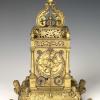Arsenius, Astrolabe (1565)
Commentary
Astrolabes are multifunctional astronomical instruments and can be used to tell the time, to determine the length of day and night, to simulate the movement of the heavenly bodies, for surveying and for astrological purposes. By observing the positions of the stars or sun, measuring their inclination and aligning the movable parts of the astrolabe accordingly, one can create a flat model of universe for that moment in time. The annotations above guide one through its different parts and how they relate. While most astrolabes are made up of the same basic components, certain features can help us identify where and when each model was made. The rete of this astrolabe, for example, is in the shape of a tulip, typical of Flemish models of the sixteenth century.
To find out more about astrolabes, how they work and their history, see the description of 'Western Astrolabes' on the Starry Messenger website.
Arsenius's Astrolabe: Epact Entry
This astrolabe is, by any standards, an exceptionally fine if not untypical piece of craftsmanship from the renowned Arsenius workshop of Louvain. Close inspection, however, reveals a number of flaws in its execution: several words on both sides of the mater and plate have been wrongly engraved and rather crudely corrected, and the throne (in which the woodland deities faunus and fauni support a heraldic centrepiece rather than the compass more usual for Arsenius) bears holes in its casting. Although the instrument, along with three other surviving astrolabes, is explicitly signed by Regnerus Arsenius, controversy still surrounds whether this maker is one and the same as Gualterus Arsenius, the founder of the Arsenius workshop, or a close relative or associate.
Four astrolabes survive signed by Regnerus Arsenius but controversy still surrounds whether this maker existed in his own right or whether he was one and the same as Gualterus Arsenius. The earliest known Arsenius astrolabe, now in Mexico City, is dated 1554.
- For a more detailed description, see 'detailed text' in its entry in the MHS Collections Database.
- For more on the Louvain workshop, see Giles Hudson's commentary here.

